Infrared images can be displayed just like red, green, or violet filter frames. When we use an infrared filter in place of one or more visible colors, we say that the picture is a false color image.
False color images are useful for studying ice on Europa and volcanoes on Io. But the most dramatic examples may be from our own planet! During its second flyby of Earth in December 1992, Galileo captured these views of Arabia and North Africa:
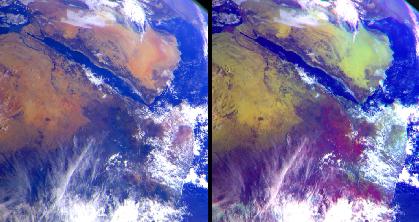 Arabia enhanced-visible and false
color.
Arabia enhanced-visible and false
color.
The false-color picture on the right is made up of images taken with infrared, red and violet filters. One of the camera's infrared filters (that is transparent only to light at a wavelength of 0.73 microns) is displayed as red, so the red regions in the picture are areas that appear bright at this wavelength. These are mostly places with dense vegetation, such as the Ethiopian highlands and the Nile River and Delta.
Earth-orbiting spacecraft routinely monitor the global inventory of vegetation on our planet by imaging at infrared wavelengths. Vegetation is much brighter in the infrared than it is at visible wavelengths, since chlorophyll absorbs much of the visible light to convert to chemical forms of energy. An example of how plants on the surface would look to Galileo's camera is shown below.
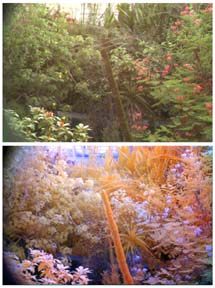 True and false-color pictures of vegetation inside Biosphere II.
True and false-color pictures of vegetation inside Biosphere II.
Vegetated areas that are dark at visible wavelengths can be clearly seen as red regions in the false color image below. Moist clouds laden with water vapor appear magenta (purple) in color, in contrast to dry clouds made up mostly of ice crystals which look white in this picture. The coarse grained snow and ice of Antarctica is a spectacular cyan hue.
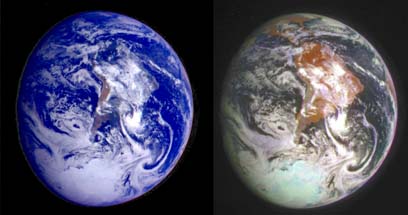 Earth in true and false color
Earth in true and false color
A close-up of Antarctica was taken by Galileo during its second flyby of Earth. Here is a comparison between the true and false color versions of the McMurdo region:
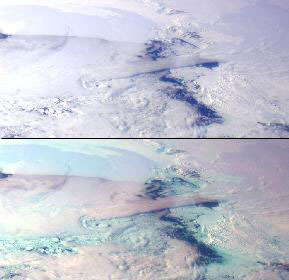 Antarctica in true and false color
Antarctica in true and false color
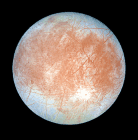 Jupiter's moon Europa viewed in the same false
colors
Jupiter's moon Europa viewed in the same false
colors
The cyan (blue-green) color of coarse grained ice in false color pictures has important applications to Europa. Unlike the other icy moons of Jupiter, Europa appears distinctly blue at infrared wavelengths. Here is a comparison between enhanced visible and infrared images of Europa from orbit 1:
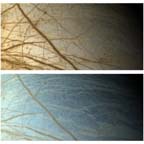 Europa visible and infrared views from
orbit 1
Europa visible and infrared views from
orbit 1
Combining visible and infrared pictures produces a striking portrait that has given Europa an unfair reputation as a "blue moon":
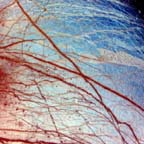 Europa false color combining visible and infrared bands
Europa false color combining visible and infrared bands
Something else that infrared images can show better than humans could see is volcanic lava that glows because it is hot. On Io, you can sometimes spot volcanoes by their infrared glow even during day time. Look at the center of the bullseye below:
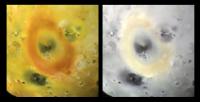 Io's volcano Pele in visible and IR images from orbit 24
Io's volcano Pele in visible and IR images from orbit 24
Glowing lava is easier to see at night, and Galileo took many pictures of Io in the darkness of Jupiter's shadow to spot new volcanic eruptions. Usually these were clear filter images with long exposure times to capture as many photons as possible. Even though they are not color images, we can use pseudocolor to help see small brightness variations.